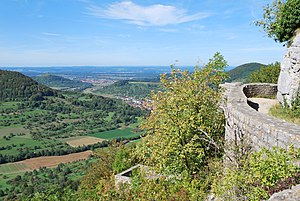Under the fall
|
Unter dem Burz nature reserve
|
||
|
View from Reußenstein to the nature reserve on the left at the lower edge of the forest with juniper heather towards Neidlingen. In the background the Limburg castle ruins |
||
| location | Germany , Baden-Wuerttemberg , Esslingen district , Neidlingen | |
| surface | 26.9 ha | |
| Identifier | 1190 | |
| WDPA ID | 165991 | |
| Geographical location | 48 ° 34 ' N , 9 ° 33' E | |
|
|
||
| Setup date | 11/20/1992 | |
| administration | Regional Council Stuttgart | |
Unter dem Burz is a nature reserve (NSG number 1.190) designated by ordinance of the Stuttgart regional council of November 20, 1992 in the area of the municipality of Neidlingen in the Esslingen district in Baden-Württemberg .
The 26.9 hectare (ha) nature reserve is between 480 m above sea level. NN and 760 m above sea level NN directly adjacent to the local area west of the municipality of Neidlingen and belongs to the natural area of the Middle Kuppenalb .
It is an area characterized by various uses. Wasteland and fallow land, streams, damp depressions and still waters, ravines and orchards alternate. The juniper heather encloses a meadow area on three sides, which is partly covered with fruit trees. The heather is divided by numerous hedges and groups of bushes, hedges along the edges protect the area from external disturbances.
The purpose of protection is the preservation of communities and habitats of certain animal and plant species and because of the diversity, character and beauty of the natural features. The landscape is dominated by the juniper heath with lime-lime lawns, groups of trees and warmth-loving edges. As an ecologically valuable addition, orchards and sage and oat meadows follow. In addition, there are natural deciduous forests, in particular dry white Jura beech forest and fresh white Jura beech forest with transitions to the canyon forest. Ash and sycamore maple, enriched by sycamore elm, bird cherry and black elder, form a very natural forest.
Due to the different water balance, noble germander (Teucrium chamaedrys) , mountain germander (Teucrium montanum) , upright ziest (Stachys recta) and sickle clover (Medicago falcata) can be found in the area of the lean lawn in dry to alternately dry locations . The marl soils are also the typical location of the blue-green sedge (Carex flacca) , the mosquito-handelwort (Gymnadenia conopsea) and the willow tree (Inula salicina) as well as numerous species of orchids. The immigrant species of the fringing societies include the swallowwort (Vincetoxicum hirundinaria) , the branchy grass lily (Anthericum ramosum) , the wild dost (Origanum vulgare) and also the rough violet (Viola hirta) .
In the springy areas of the Upper Brown Jurassic, the pipe grass (Molinia coerulea) , the hem-sedge (Carex hostiana) and the devil's bite (Succisa pratensis) are special features . The great flea herb (Pulicaria dysenterica) , the horse mint (Mentha longifolia) and the blue-green rush (Juncus inflexus) are characteristic species of the rush meadows on wet to semi-humid locations. Meadowsweet (Filipenudla ulmaria) , swamp cranesbill (Geranium palustre) , valerian (Valeriana procurrens) and cabbage thistle (Cirsium oleraceum) can be found in very moist and nutrient-rich locations. The occurrence of the grape hyacinth (Muscari) is also remarkable .
See also
literature
- Reinhard Wolf , Ulrike Kreh (Hrsg.): The nature reserves in the Stuttgart administrative region . Thorbecke, Ostfildern 2007, ISBN 978-3-7995-5176-2 , pp. 497-500.
Web links
- Profile of the nature reserve in the LUBW's list of protected areas



